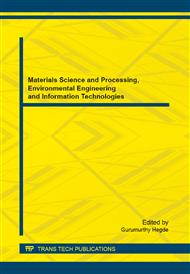[1]
WANG QUANHONG, XU KENAN, TAKAHARAG, et al. Device placement for heterogeneous wireless sensor networks: minimum cost with lifetime constraints [J]. IEEE Transactions on Wireless Communications, 2007, 6(7): 2444-2453.
DOI: 10.1109/twc.2007.05357
Google Scholar
[2]
Reference to a chapter in an edited book: DAI SHUCHENG, TANG CHANGJIE, QIAO SHAOJIE, et al. Optimal multiple sink nodes deployment in wireless sensor networks based on gene expression programming[C]. 2010 Second International. Conference on Communication Software and Networks. Washington, DC: IEEE Computer Society, 2010: 355-359.
DOI: 10.1109/iccsn.2010.33
Google Scholar
[3]
V Katiyar, N. Chand,G. C. Gautam, A. Kumar, Improvement in LEACH protocol for large scale wireless sensor networks[J]. Proc. 2011 International Conference on Emerging Trends in Electrical and Computer Technology (ICETEC), India, March (2011).
DOI: 10.1109/icetect.2011.5760277
Google Scholar
[4]
WU X H, WANG SH. Performance comparison of LEACH and LEACH-C protocols by NS2[C]. 2010, Ninth International Symposium on Distributed Computing and Applications to Business, Engineering and Science, Beijing, China. 2010: 254 - 256.
DOI: 10.1109/dcabes.2010.58
Google Scholar
[5]
Lindsey S, Raghavendra CS. PEGASIS: Power-efficient gathering in sensor information systems [C]. In: Proc. of the IEEE Aerospace Conf. Montana: IEEE Aerospace and Electronic Systems Society, 2002: 1125-1130.
DOI: 10.1109/aero.2002.1035242
Google Scholar
[6]
Georgios Smaragdakis, Ibrahim Matta, Azer Bestavros. SEP: A Stable Election Protocol for clustered heterogeneous wireless sensor networks[R]. Technical Report BUCS-TR-2004-022: 1-11.
Google Scholar
[7]
J.N. Al-Karaki A.E. Kamal. Routing Techniques in Wireless Sensor Networks: A Survey [J]. IEEE Wireless Communications, Dec, 2004, 11(6): 6-28.
DOI: 10.1109/mwc.2004.1368893
Google Scholar
[8]
LEE S, SRIRAM K, KIM K, et al. Vertical handoff decision algo-rithms for providing optimized performance in heterogeneous wireless networks[J]. IEEE Trans on Vehicular Technology, 2009, 58 (2): 865-881.
DOI: 10.1109/tvt.2008.925301
Google Scholar
[9]
K. Alsabti,S. Ranka,V. Singh. An Efficient K-Means Clustering Algorithm. http: /www. cise. ufl. edu/- ranka/, (1997).
Google Scholar
[10]
Heinzelman W R, Chandrakasan A, Balakrishnan H. Energy efficient communication protocol for wireless micro sensor networks[C]. Procedings of the 33rd Annual Hawaii International Conference on System Sciences. Hawaii. USA: 2000. 10-19.
DOI: 10.1109/hicss.2000.926982
Google Scholar
[11]
B. Manzoor, N. Javaid, O. Rehman, M. Akbar, Q. Nadeem, A. Iqbal, M. Ishfaq. Q-LEACH: A New Routing Protocol for WSNs [J]. Procedia Computer Science, 2013(19): 926-931.
DOI: 10.1016/j.procs.2013.06.127
Google Scholar


